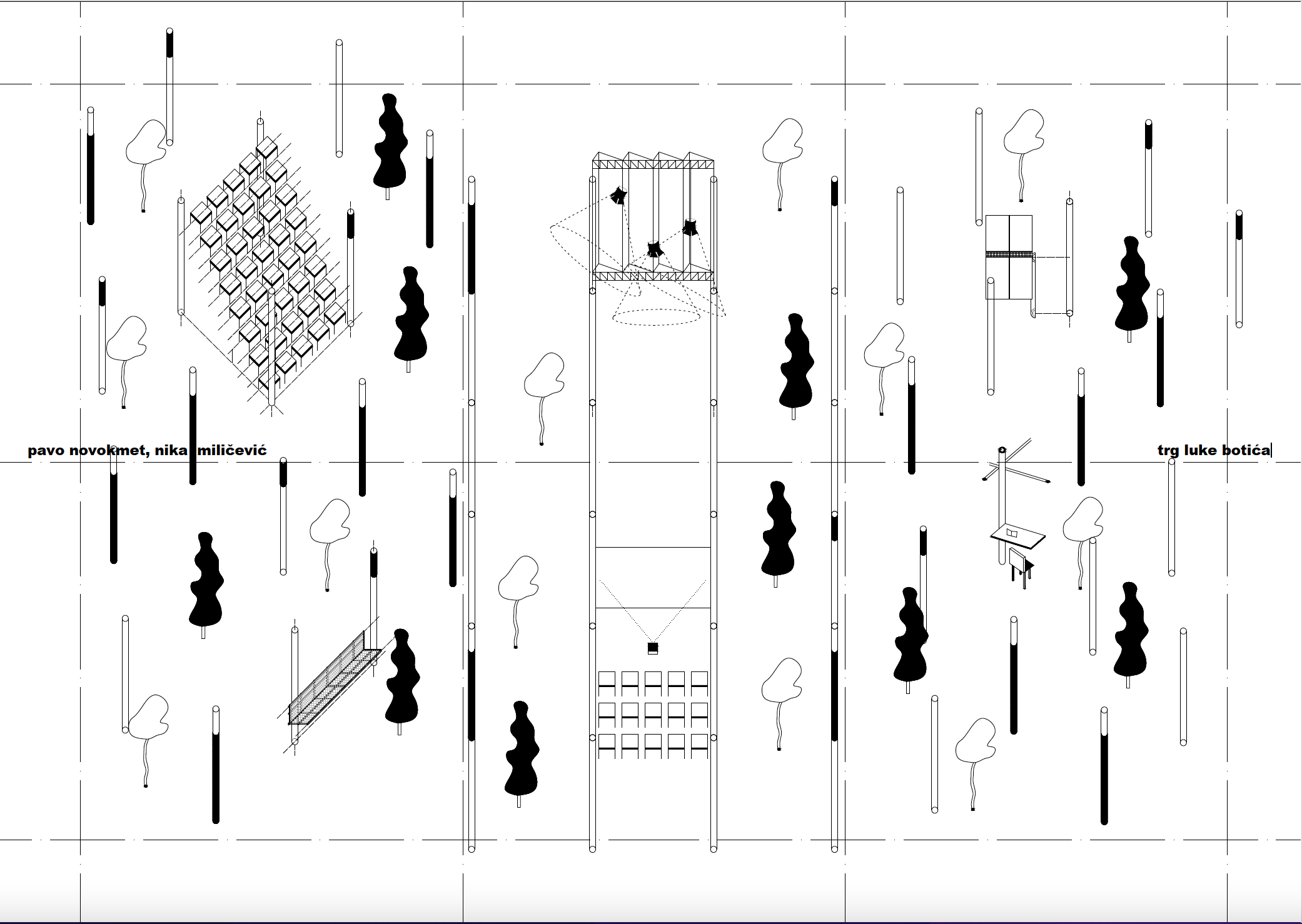Gesamtkunstwerk of Stimuli
Matej Barić and Damjan Brundić
The only way to perceive architecture as a corporal experience is through an amalgamation of sensory inputs. When the entirety of the carnal becomes a medium for perception, an actualization of corporality within a spatial sequence emerges, culminating in a Gesamtkunstwerk of stimuli.
The focus shifts decisively to the void, where its interplay with vibration becomes perceptible. Light, frequency, and the presence or absence of an atmospheric medium serve as vessels for visualizing this phenomenon. Sound is experienced not only through the tympanic membrane but through the body as a whole.
The Meštrović Pavilion has been chosen as the custodian of this occurrence. Its vertical axis and rotunda layout immerse visitors in the vapor formations, creating a multisensory engagement with the space.
Through a careful arrangement of haze machines and directional lighting, resonant frequencies of the space itself emanating from a 9-meter diameter steel plate activated by powerful transducers create standing waves whose compression and rarefaction zones are subtly made visible in a stunning play of ephemeral forms.
Light frequency and sound converge as a site-specific spatial intervention medium.
Vibration, Darkness, Space
Marta Hrkalović ——————-
Darkness is the threshold, the condition for true immersion. It obliterates preconceptions, swallows the striated and opens space to its infinite depths. In darkness, sound and vibration, we find a haptic encounter with space - a resonance that is felt and through which space is not only perceived but lived, altered, ultimately left forever changed.
To truly immerse oneself in the experience led by vibration, darkness becomes essential. Darkness is not an absence but a veiling, a presence that unseals space anew and strips perception down to its raw beginnings. It is within this void of unknowing, that the smooth emerges - a primordial state of perception, unformed, unbounded and untethered from the constructs of light and line. Here, the mind exists in a suspended intimacy with its surroundings, free from the constraints of seeing and knowing. Smoothness is not merely a quality of space, but an extension of the perceiving mind itself, fluid and infinite, unbroken until disrupted.
As the perceiving mind begins to orient itself, the smooth begins to transform. It walks, feels, tastes the space and in doing so, it reacts. This reaction is a mapping, a translation, a transition into striated space - a world which is organized and conditioned. Architecture, air, light: all are striated as they are planned, trapped, and subjected to the measures of design. Darkness acts as a medium, a bridge between these two states. Light delineates and defines, but darkness engulfs. It resists conditioning; it offers vastness. Space becomes infinite and true immersion reveals itself - not through clarity, but through obscurity. When darkness occupies a space, architecture within its physical confines is nullified. Instead, space begins to be defined by vibration. Synthetic sound expands architecture, widening the plan and elongating the section, creating new depths that stretch beyond the material reality. In the absence of light, vibrations shape the experience of the built environment.
The interplay between smooth and striated becomes recursive. Smooth space is constantly translated into striated space, as striated space is deconstructed and returned to smoothness. This rhythm echoes the nature of perception itself - a reverberating connection between proximity and distance, freedom and structure, intuition and organization. As Deleuze and Guattari suggest, smooth space belongs to haptic intimacy, where the body and the mind lose themselves in the immediate, the close, the undefined. Striated space, by contrast, arises through measure, planning, and geometry - a distant vision that seeks to control and contain. Yet even within striated space, the potential for catastrophe exists; a rupture that collapses the structure and opens the way for new smoothness.
Pulse-Membrane
Pavo Novokmet, Nika Miličević, and Anja Škurla
This concept delves into communication on a fundamental sensory level, where the material, like a living membrane, responds to the user's physiological changes, creating a microcosm that explores the boundaries of perception and introspection. The project explores the creation of a cover / membrane that responds to the user's heartbeat, establishing communication between the body and the cover itself. The membrane, capable of expanding and contracting, reacts to the user’s internal signals, such as pulse, and creates conditions similar to an anechoic chamber — a space without external sounds, where the user can only hear their own heartbeat. In this way, an intimate connection is formed between the autonomic nervous system, the conscious, and the subconscious, reminiscent of the experience within the womb.
Constructive Vibrations
Rebecca Bobetko ——————-
WHAT IF WE CONSTRUCT SPACES USING VIBRATION AS A CONSTRUCTIVE ELEMENT? FROM DESTRUCTION TO CONSTRUCTION… THE CONCEPT OF USING VIBRATIONS, USING SOUND WAVES TO CREATE A CONSTRUCTION. INSTALLATION THAT IS HELD AND DRIVEN BY SOUND WAVES.
The grain structure of steel during heat treatment causes steel to change its microstructure and properties, steel becomes firmer and if you look at it under a microscope, its molecular structure is not as fragmented as it was before… heat on the molecular level can induce sound by activating vibration in an object due to thermal movement that sets air to vibrate and produces sound we hear. What if the sound vibration of certain materials in a certain construction or installation can cause the stability of a construction? What if we construct spaces using vibration as a constructive element? So, we have "harmful" vibrations like earthquakes or resonance in architecture which can cause destruction...but, what if we do the opposite of that? From destruction to construction... the concept of using vibrations, using sound waves to create a construction. Installation that is held and driven by sound waves.
SOUNDFIELD
Pavo Novokmet and Nika Miličević
The Square of Luka Botić, like an isolated island enclosed by a major roadway and urban topography, represents a remnant of the necessary public space that is systematically lost in favor of other seemingly more important programs. A space without a designed public function cannot survive—it is the content that gives it meaning. It makes it a place. A place of encounters, events, and collective memory.
An unplanned public space spreads like a virus, infecting its surroundings and degrading everything around it. Public spaces are not isolated issues; they always resonate within a broader context. It is up to society to decide what kind of echo that will be.
The square was originally designed with sensitivity to the importance of such a place. However, years of systematic neglect have left behind only remnants of its former character.
Impression
Vision
The presence of a major roadway adjacent to the site results in high levels of noise and pollution from smog. The lack of public amenities within the area diminishes its perception as a public urban park or square.
The future design solution should consider the need for a designated waiting area, functioning as an add-on to the station, as well as content that activates and affirms the park space as a place for gathering, events, and a school square.















